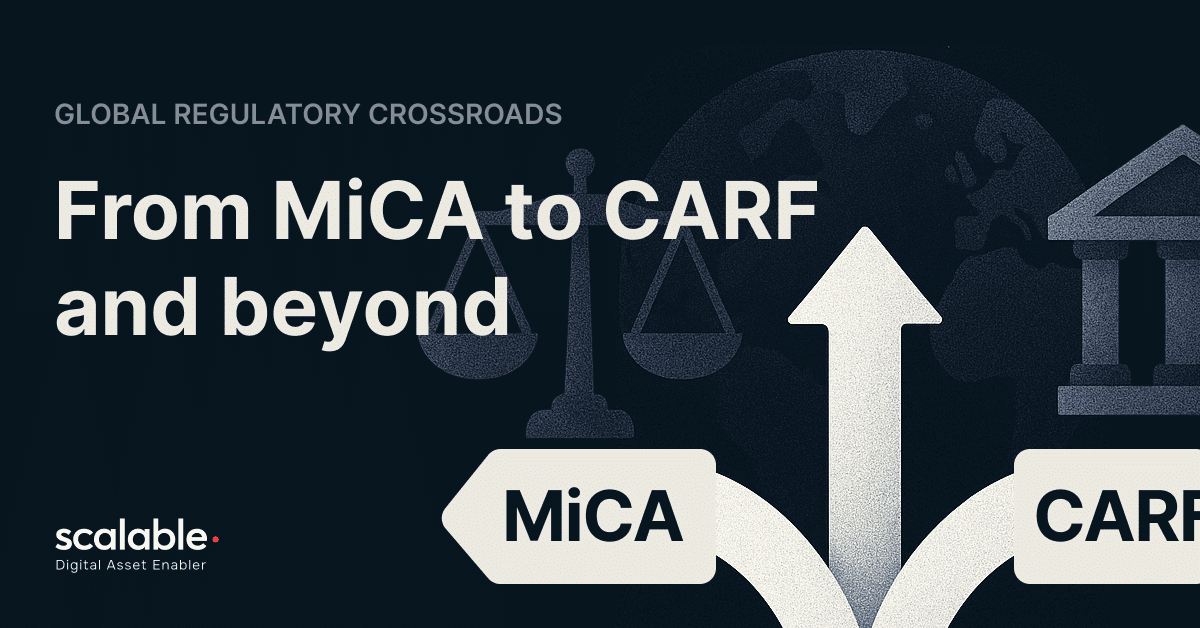Global Regulatory Crossroads: From MiCA to CARF and Beyond

June 2025 brings just another round of crypto news leading to a major structural shifts. Key jurisdictions are stepping in with frameworks that, while not yet synchronized, signal a collective push toward maturity, compliance, and mainstream integration.
Let’s dive into the most influential moves this month, and what they mean for startups, investors, and institutions.
🇺🇸 U.S. Lays Down the Stablecoin Groundwork with the GENIUS Act
The U.S. Senate passed the GENIUS Act - one of the most advanced federal frameworks for stablecoins to date.
Key Features:
All stablecoins must be backed by equivalent real-world assets (Treasuries, cash, short-term debt).
Issuers must publish detailed attestations, ensuring reserve transparency.
In case of issuer failure, holders have legal claim over reserve assets—similar to deposit insurance.
Strategic Implications:
Reduces counterparty risk, especially for institutional adoption of USDC and similar products.
Provides legal clarity for banks and payment processors to engage with stablecoins directly.
Reinforces U.S. positioning to counterbalance China's digital yuan strategy.
At the same time, the June 6 Executive Order put enforcement muscle behind this regulatory push - emphasizing AML/KYC standards, enhanced oversight of crypto-to-fiat on/off ramps, and collaboration between the SEC, CFTC, and FinCEN. Together, these measures form a foundation for regulated DeFi and tokenized finance in the U.S. While the debate around Ethereum’s classification and broader crypto tokens continues, stablecoins may serve as the trojan horse for institutional adoption.
🇪🇺 MiCA Enforcement Begins: Europe Doubles Down on Compliance
The Markets in Crypto-Assets Regulation (MiCA) officially entered its enforcement phase this June. For many players in the EU, this isn’t new - but compliance is now mandatory, with penalties in place.
What MiCA Enforces:
Licensing for all crypto service providers (CASPs), including exchanges, wallets, and custodians.
Stablecoin rules: Reserve mandates, daily issuance caps, and centralized governance disclosures.
Token whitepaper requirements to standardize information disclosure.
Strict consumer marketing guidelines to reduce retail mis-selling.
Simultaneously, the EU is fast-tracking alignment with the OECD’s Crypto-Asset Reporting Framework (CARF). This framework introduces automatic exchange of taxpayer information on crypto transactions across jurisdictions.
MiCA is now influencing third countries like Switzerland, Liechtenstein, and even UK-based firms interacting with EU clients. CARF compliance will standardize tax reporting globally, cutting down on regulatory arbitrage. Binance, Kraken, and Coinbase have all made public compliance moves in the EU. European VC firms are pushing for tokenomics models to be restructured in anticipation of MiCA audits.
🌏 Asia's Regulatory Mosaic: From Soft Paper to Bold Legalization
🇮🇳 India
The Ministry of Finance released a discussion paper that, while not yet legislation, outlines:
Taxation of crypto assets as part of a new financial instruments class.
Emphasis on centralized KYC onboarding.
Coordination with the Reserve Bank of India to create a regulatory sandbox.
India, which saw over 100 million crypto users, has moved from uncertainty to a risk-managed innovation approach. This could unlock enterprise blockchain and CBDC integration pathways.
🇻🇳 Vietnam
In a major surprise, Vietnam formally legalized the use and trading of crypto assets. The June 14 law includes:
Clear classification between crypto tokens, utility tokens, and securities.
A national AML framework enforced by the Ministry of Public Security.
Licensing regime for exchanges with real-time reporting obligations.
Vietnam’s 17 million+ crypto holders (according to Chainalysis) now operate in a fully legal environment - making the country a regional hub for crypto-fintech convergence.
🇵🇰🇯🇵 Pakistan & Japan
Both countries advanced compliance with OECD’s CARF. Japan is additionally exploring an institutional-grade digital yen sandbox for cross-border settlement.
Asia remains diverse in its approaches - but the overarching trend is structured engagement over suppression. We're seeing regulatory pragmatism rather than sweeping bans.
🌐 OECD’s CARF: The Silent Force Driving Global Alignment
The Crypto-Asset Reporting Framework (CARF) may be less headline-grabbing than MiCA or the GENIUS Act - but its influence is quietly reshaping global tax policy.
What CARF Requires:
Financial institutions and VASPs must report crypto holdings and transactions tied to taxpayer IDs.
Governments must automatically exchange that data across borders.
OECD's 2027 enforcement deadline is already pushing early adoption in Germany, Canada, Japan, and Australia. Major exchanges and custody providers are adjusting back-end systems to meet CARF-compliant reporting standards.
CARF is becoming the global backbone for tax transparency in crypto. Over time, it may function like the Common Reporting Standard (CRS) in traditional finance - reducing regulatory arbitrage and increasing cross-border cooperation.